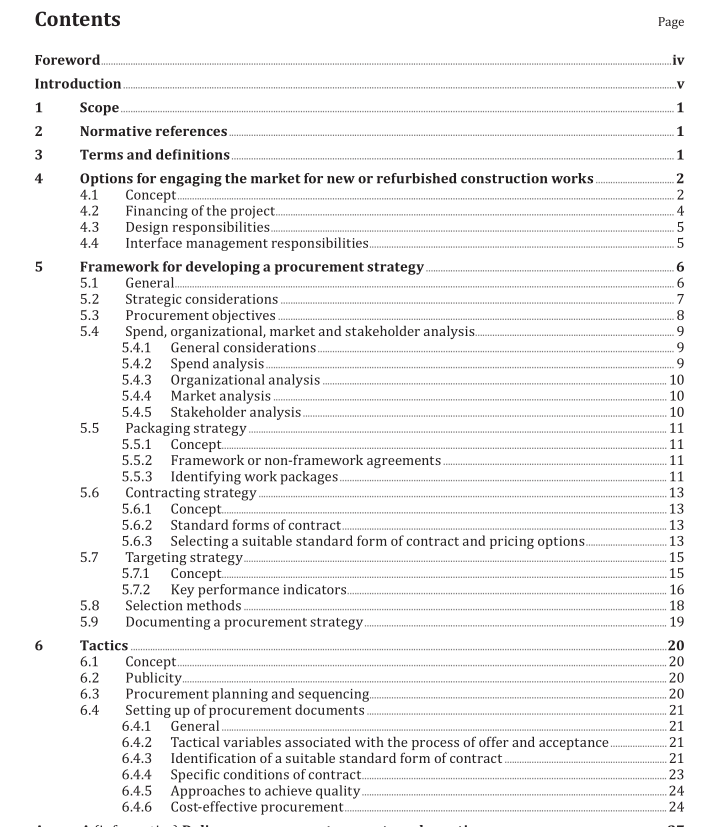ISO 22058 pdf download

ISO 22058 pdf download Construction procurement — Guidance on strategy and tactics
The parties to the contract can agree to share skills, technology and responsibility and transfer risks. Partnership arrangements can take on different forms to address issues such as spreading the cost of investment over the lifetime of the construction projects, greater predictability over cost and time, lowering of procurement costs, flexibility of programme delivery, performance incentives, potential to be off-balance sheet, ability of public sector to retain influence over strategic decisions, potential for continuous improvement through successive phases of work and early commercial input from private sector parties. Public sector partnering arrangements vary with the level of involvement and risk that the private entity holds in the arrangement with the public entity and how projects are financed.
Partnership arrangements can range from simple collaboration to mitigate risks to the transfer of risks to the private party to the extent that this party puts its own capital at risk by funding its investment in the project with debt and shareholder equity. Partnership arrangements may also include the setting up of joint ventures to deliver specific projects, payment based on successful delivery, transferring of institutional function to the private party and permitting the private party to make use of public property. The client’s involvement in the delivery management of a project where the market funds the project is generally limited (see Annex A). In procurements of this kind, a client may need to appoint a transaction advisor as the other party to the contract oversees or has already overseen the delivery of the project.
A client nevertheless needs to undertake a procurement process or negotiate a contract to acquire the outcomes associated with the selected project delivery route. Furthermore, clients need to source some professional capacity to ensure that due diligence is undertaken at an appropriate level to confirm that the requirements of the contract are delivered in accordance with the terms of the contract. The financing of the project on a “make” basis, on the other hand, requires the client to directly pay all contractors for the goods and services associated with the delivery of the project incrementally as the works proceeds. It also requires that the client play an active role in the delivery of the project as indicated in Annex A and to make decisions regarding the allocation of design and interface management responsibilities between the parties to a construction contract. A client needs to appoint professional service providers to undertake design and interface management responsibilities which it has retained,where it lacks in-house professional expertise to assume these responsibilities. Accordingly, decisions made regarding responsibilities for design and interface management determine the nature and number of professional service agreements that are entered into. Strategies and tactics appropriate to the selected option to engage the market need to be adopted to attain desired outcomes.
4.3 Design responsibilities A client can retain design responsibility, in which case the contractor undertakes construction on the basis of production information issued by the client (design-by-client strategy). Alternatively, the client can assign design responsibility to the contractor in which case the contractor:
— designs the works based on requirements established by the client and constructs it (design-and- construct strategy) or provides a solution to the client’s requirements and manufactures and installs the required works or component thereof (design-and-supply strategy); or
— completes the production information based on a scheme design provided by the client and constructs it (develop-and-construct strategy). In the design-and-construct and develop-and-construct strategy, a client needs to have a capability to procure the necessary professional resources to develop the end-of-stage deliverables which form the basis of the scope of work for a contractor who is assigned design responsibilities. This is also necessary for the reviewing of the outputs of the contractor for general conformity with the scope of work and what has been agreed at each stage following the appointment of a contractor. A client may, to obtain continuity in aspects of the design, novate professional service providers to a contractor as a condition of contract e.g. mechanical design. (Novation is the substitution of a new contract in place of an old one or the substitution of one party for another party in a contract.)









